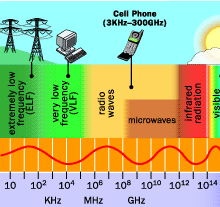|
Microwave Radiation  Microwaves
Microwaves of long wavelength (or low frequency) are sometimes called short wavelength (or high frequency) radio waves - and those of the short wavelength get called long wavelength (or low frequency) infra red waves. This is usually done to avoid describing the radiations as 'microwave' radiation. The 'scares' in the communication industry relating cell phone microwave radiation to brain tumours have made some companies re-brand the radiation to avoid the word 'microwave'. Health Concerns Microwaves are not of a high enough energy to ionise atoms they therefore cannot chemically change substances and will not change DNA coding and cause cancers like X-rays and gamma rays can. They are an example of non-ionizing radiation. SAR Rating Only compare like with like in research In the USA, a SAR limit of 1.6 W/kg, averaged over a volume of 1 gram of tissue, for the head has been set. In Europe, the limit is 2.0 W/kg, averaged over a volume of 10 grams of tissue. SAR values are heavily dependent on the size of the averaging volume. Without information about the averaging volume used comparisons between different measurements cannot be made. Thus, the European 10-gram ratings should be compared among themselves, and the American 1-gram ratings should only be compared among themselves. SAR data for specific mobile phones, along with other useful information, can be found directly on manufacturers' websites, as well as on third party web sites. How to reduce your exposure to phone radiation
You should be aware that if the phone is receiving a very strong signal from a base station, then power output can be reduced by up to 1000 times compared with when the phone has a poor signal. Heating effect in humans When injury from exposure to microwaves occurs, it usually results from heating in the body. Exposure to high levels of microwave radiation can produce cataracts by this mechanism, because the microwave heating denatures proteins in the crystalline lens of the eye (in the same way that heat turns egg whites white and opaque) faster than the lens can be cooled by surrounding structures. The lens and cornea of the eye are especially vulnerable because they contain no blood vessels that can carry away heat. Exposure to heavy doses of microwave radiation (e.g. from an oven that has been tampered with to allow operation even with the door open - usually as soon as you open the door the production of microwaves stops) can produce heat damage in other tissues as well, up to and including serious burns which may not be immediately evident because of the tendency for microwaves to heat deeper tissues with higher moisture content. Tumour growth It has not been shown conclusively that microwaves (or other nonionizing electromagnetic radiation) have significant adverse biological effects at low levels. Some but not all studies suggest that long-term exposure may have a carcinogenic effect. This had led to concerns over the prolonged use of mobile (cell) phones by children. The Stewart Report was commissioned to look into this in 2000. It recommend that a precautionary approach to the use of mobile phone technologies be adopted until much more detailed and scientifically robust information on any health effects becomes available. Since then a further report was made in 2005 in which Sir Stewart expressed concern that no clear indication of safety had been confirmed and that the precautionary principle should still be adhered to. During World War II, it was observed that individuals in the radiation path of radar installations experienced clicks and buzzing sounds in response to the microwaves radiation. This microwave auditory effect was thought to be caused by the microwaves inducing an electric current in the hearing centers of the brain. Research by NASA in the 1970s has shown this to be caused by thermal expansion in parts of the inner ear. The mobile phone is such a popular useful device that brings in vast amounts of government revenue from taxes and licence sales that many factors other that absolute safety are involved in deciding whether cell phones should be sold to children... or where mobile masts should be positioned. Nothing has be proven - not that microwave radiation is safe or that it isn't. It will take many more years of study to determine. To get an idea of the sort of studies that have been carried out I recommend this Wikipedia page. Applications of Microwave Radiation:
|
Follow me...
|


 The wavelength of mircowaves are between 1 millimetre and 1 metre
The wavelength of mircowaves are between 1 millimetre and 1 metre
 Part of the radio waves emitted by a mobile telephone handset are absorbed by the human head.
Part of the radio waves emitted by a mobile telephone handset are absorbed by the human head. 


